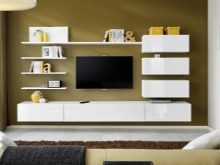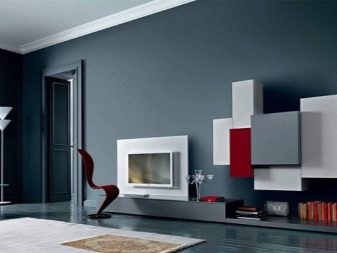Wall design with TV in the living room

Every day, our eyes are directed to the TV, so special attention should be paid to its location and design. Our article will tell you how to harmoniously fit the TV zone into the interior.


TV placement options
It is better to place the TV at an optimal distance from the sofa. The height is also determined based on the convenience of the audience. The TV set should not hang too high. Nor should it be placed on a very low stand. The choice of the diagonal depends on the size of the room.
In a small room, a medium-sized model mounted on a wall or ceiling will look better. Large equipment can be accommodated in the spacious hall. Usually, for the TV zone, the side opposite the window or perpendicular to it is chosen.
If you decide to put the TV in the same place where the window is, you should take care of buying thick roller blinds or blinds. Otherwise, sunlight will interfere with viewing.






In general, there are several options for placing a TV.
- On the wall. The easiest option is to attach it to the wall.
- In the corner. Corner placement is sometimes the best solution. This technique helps to save space in a small space and gives more room for the implementation of design ideas.
- In a niche. If the layout provides for a niche, the TV will fit perfectly into it.
- In drywall. The plasterboard construction with a niche that matches the size of the TV creates the effect of built-in technology.
- On a nightstand. If you have chosen a model on a stand, you can place it on the nightstand.
- In the center of the room. If the hall is very large, it is inappropriate to place a sofa and a TV set against opposite walls - the distance will be too large. If you don't want to clutter up the center of the hall with upholstered furniture, you can build a mini-plasterboard partition and place the TV receiver on it.
- On a large partition. If a large partition has been built in a studio apartment separating the cooking and recreation areas, you can use it for the TV area as well.
- On the ceiling. A ceiling mount can be very handy. This eliminates the need to allocate a dedicated TV space. In addition, such a solution looks quite elegant. The device hangs freely in the air and can be rotated in any direction.
- In a furniture complex. Many modern walls and shelves provide space for a TV area. This is very convenient, since there is no need to think over the nuances of the design of the location of the equipment. The result is a harmonious and attractive composition.
- Above the fireplace. Fire calms, pacifies, creates coziness. If you are sure that the dancing flame will not distract from the screen, you can hang the TV over the fireplace. The main thing is to maintain compliance with the sizes. Both elements should have approximately the same dimensions.
- Disguise. Sometimes, for some reason, the owners want to hide the TV. This can be done by hiding it behind a retractable door.






Materials for wall decoration
If you decide to hang the TV on the wall, you can make it accent. Striking finishes will grab attention, and the technique won't look like a lonely dark spot. On the contrary, it will become the center of an interesting design composition.






Decorative rock
Natural stone or its imitation will create an unobtrusive accent on the TV zone. At the same time, it will look solid and expensive.



Wallpaper
This decoration option is available to everyone. The TV zone can be distinguished with a canvas that differs from the rest of the walls, for example, with a discreet pattern. The main thing is to avoid too bright colors and contrasting prints.
Plot drawings and wallpaper are especially contraindicated. This will distract from what is happening on the screen.



Brick
Decorating internal surfaces with brickwork is gaining popularity every year. Indoors brown, gray and white bricks look equally good. The interior turns out to be textured, acquires a special character and bright personality.



Laminate
Most people are used to seeing this material on the floor. However, in some cases it turns out to be very successful in using it for wall decoration.


Gypsum wall panels
Plaster panels with a 3D effect are a great option. They allow you to make the wall unusual without the use of flashy colors and colorful patterns. Even white panels in this design look luxurious.



Color spectrum
First of all, it is worth choosing the color of the TV case. It is desirable that he harmoniously fit into the environment. Most models are sold in black universal frames, although there are other options. Then it is worth considering in what color to decorate the wall on which the equipment will be located. In this case, one should take into account the style of the interior, the general color scheme of the room, furniture.
Despite the fact that the TV area can be highlighted with a different shade, it is better to choose a calm color for finishing. If you want the technique to stand out against the wall, choose a light tone (beige, light gray, pale purple, or another pastel shade).
The most effective combination is a black TV on a white background.






If, on the contrary, you do not want to focus on technology, you can stop at a dark color. Brown or dark gray is a good choice. Choosing black to decorate your TV wall is an interesting move. So the technique will merge with the background, as if dissolving into it.
You shouldn't choose bright colors, they will annoy and distract from the screen. If a monochromatic neutral design seems boring to you, you can use an texture - decorate the wall with another material. The versatility of space is also a good design technique. The location of the device in the niche will attract attention in itself. Low-key drawings are also acceptable.


Style solution
When decorating a living room, it is important to adhere to the chosen interior style. This applies to everything: design, colors, and finishing materials.



Classic
You can add modern technology to an elegant, classic interior with a few tricks. If you do not want to hide the TV in a closet or behind a screen, you can decorate it with moldings, stucco moldings. You can place it in a niche, surrounding it on both sides with shelves with books or columns.
Do not just frame the technique, trying to create an imitation of the picture in this way. It will look ridiculous and cheap. It is also undesirable to hang the TV over the moldings - they should frame it. Only in this way will the composition be neat and harmonious. Otherwise, the TV will seem superfluous.
Plaster, wallpaper, stone can be used for wall decoration. The range of colors includes noble, usually warm shades (milky, beige, brown). Sometimes burgundy, dark green, blue colors are used in the interior.
In the neoclassical direction, there may be bright accents (turquoise, purple). However, this usually applies to pieces of furniture and decor. The walls are decorated in neutral colors.



Contemporary styles
Minimalism and hi-tech imply rigor, clear geometric shapes, pure cool colors. Here, the TV can be surrounded by laconic glossy cabinets without fittings, or simply be located on an empty wall. As a surface decoration, painting, plain wallpaper, 3D panels are suitable. The imitation of snow-white brickwork looks good.
It is in such an interior that the black and white combination will look perfect. You can choose between gray and black for the wall. The tone of the case is also variable. If there are a lot of gray, chrome parts in the room, you can take a TV with a silver frame.
If white tones prevail, a snow-white body will also look good. As for Art Nouveau, there is more softness, warmth, woody textures.
The principles of decorating the TV zone are the same, only the shade of the wall can be different, for example, beige. A discreet print may also be present.


Scandinavian direction
This style assumes lightness, an abundance of white. The interior should be simple but cozy at the same time. In such cases, the TV is rarely hung on the wall. Usually it stands on a roomy pedestal. There may be books or flower pots nearby. There shouldn't be any special decorations and intricate designs.
The walls are always plain (white or light gray). The accent can only be made with texture, for example, white brick. However, more often this technique is not used at all, without drawing attention to the technique.


Loft
An unpainted brick of a natural shade will be appropriate here. A concrete surface will work as well. Large-sized TVs look especially good in such an interior.


Lighting selection
Usually, the TV area is not specially illuminated in any way; for comfortable viewing of films and programs, standard ceiling lighting is quite enough. However, if you wish, you can make a special backlight that is mounted behind the screen. This allows you to watch TV without main light, but not in complete darkness. It creates an interesting visual effect of a soft glow emanating from the technique. In this case, the shade of decorative lighting can be any.
If the device is installed in a niche, you can mount luminaires with soft diffusing light into it. Another option is to install the backlight behind a decorative panel on which the equipment is mounted.
And, of course, you can hang small lamps on the wall on either side of the TV area.



Decor options
If you really want to decorate the wall on which the TV is located with decorative elements, you can use one of the ideas below.
- Pictures, panels. Around the TV, you can hang pictures or panels with laconic images, black and white photos in frames. The main thing is to avoid excessive variegation.
- Shelves. This option can serve both decorative and practical functions. On the shelves you can arrange decor items, various souvenirs, flowers in pots. Or you can use them as a place for books, magazines, CDs and other small items. The placement of shelves can be either simple or original (checkerboard, cascading). The latter options are suitable for modern interiors.
- Aquarium. We have already mentioned the fireplace. By the same principle, you can combine the TV area with water decor.
- Watch. A wall clock may well fill an empty space.



Beautiful ideas
The sophisticated neoclassical interior harmoniously combines vintage and modern features. The TV sits above the fireplace, decorated with black and white photographs. The blackness of the switched off device is successfully repeated in other details of the situation (legs of chairs, floor lamp).

Calm decoration in gentle colors can also be original. The TV is located in a beige niche with a barely noticeable pattern. The silver body of the equipment fits perfectly into the light environment.

Black and white contrast always looks stylish. Here it is complemented by a 3D volumetric effect. The orchid brings a touch of sophistication and grace to a minimalistic interior.

An original modern headset is an excellent framing for a TV area. The silver TV cabinet emphasizes the predominance of ash tones in the interior.

And here is an example of an unusual two-level backlighting. Glass shelves with souvenirs make the composition even more interesting.

For information on how to decorate a laminate wall for a TV, see the next video.








